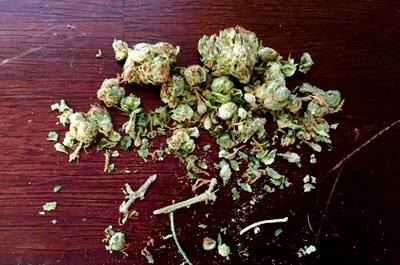
Tuesday November 23, 2021
By Trevor Ross
 420 Culture
420 Culture
Most cannabis consumers, at one point or another, find themselves wondering what to do with the leftover stems once their stash has been picked clean. And some save those stems, even if they’re not sure what to do with them. Well those instincts are correct, there are several uses for pot stems, from extraction for a little more THC, to crafting materials.
In this article we feature some of the best ways to use weed stems once the flowers are gone.
Decarb Your Stems
For cannabis to be effectively infused into anything, it must first be decarboxylated, or “decarbed.” Raw cannabis flower contains THC acid, or THCa, which cannot get the user high. The good news is that converting THCa into psychoactive THC is as easy as heating it up. Usually this happens when a flame is put to the flower, but if you’re infusing, it needs to be done at a lower temperature.
The easiest way to decarb any raw cannabis material is in the oven. Grind the cannabis stems, leaves, or flowers and spread them over a foil-lined baking sheet, then bake between 225° and 240° F for 1 hour. The cannabis should emerge brown and dry, but not burned.
Uses for Weed Stems
While there is THC in cannabis stems, it’s very little — about 2%. However, that means 1g of stems holds about 20mg of THC, or two edibles worth. Smoking plant material is still hazardous to (and hard on) the lungs, so it is not recommended that anyone smoke stems. Extracting that THC, on the other hand, opens up a few possibilities including homemade edibles, hash, and topicals.
Edibles
The THC in stems can be extracted into butter or oil just as you would when extracting from buds. Our recipe for cannabutter works exactly the same with stems in place of flowers, or you could toss your stems in with the flowers next time you extract, to squeeze out every last cannabinoid and really take your bake to its full potential.
Topicals
Cannabis topicals are an increasingly popular way to get targeted relief from pain and inflammation, and they’re relatively simple to make at home.

Coconut oil is the most common base because its high fat content allows it to soak up loads of cannabinoids. Once you have an infused base, it is mixed with beeswax or other oils like almond oil, depending on your desired consistency. Essential oils top off the aroma of your homemade balm.
Bubble hash
Bubble hash requires some specialized tool — particularly the bubble bags — but once you have the materials, you’re ready to wring every last cannabinoid out of any part of the plant.
Bubble bags have mesh sieves of varying porosity in the bottom, which are then layered atop one another in a bucket so you can catch trichomes at every level as gravity pulls them through the screens. The bags are then filled with ice, water, and any stems, leaves, or shake you may have (of course this works with raw buds as well). Then the whole mixture is stirred up, and as the trichomes freeze or become brittle, they fall off the plant and float down through the sieves. The result is a paste that dries into smokable hash.
Note that you may want to grind your stems first using a coffee grinder or something similar so that the pointy stems won’t poke through your bubble bags and make holes.
Tea or Coffee
It is possible to brew your stems into tea or coffee, but remember: THC is fat-soluble, which means it needs a lipid, a fatty substance like cream or butter, to bind to. Brewing cannabis stems in water won’t do much except flavor it like weed, but if you add a little butter, oil, or cream to that water, it will absorb the THC.

This is the principle behind our cannabis coffee recipe. The boiling water releases the remaining cannabinoids from the plant, and the butter catches them. That boiled, buttery mixture was then transferred to a french press for a rich cup of reefer java. You can infuse milk or creamer with cannabis as well.
Tincture
Cannabis tinctures have a rich history of medicinal use, and are still common today as a sleep aid and pain reliever. And thankfully, a rudimentary cannabis tincture is simple to make at home. Above, we repeated several times that THC is fat-soluble, and that’s true, but not the whole truth. Because of their similar polarities, THC is also soluble in alcohol.
To make a cannabis tincture at home, begin with a strong, but still drinkable, alcohol like everclear or vodka. Isopropyl alcohol is not safe to consume and should not be used in any kitchen recipes. Soak your stems, leaves, buds, etc. in a jar of alcohol for anywhere between 5 minutes to 5 weeks, then filter out the plant matter, and that’s it. What remains in an alcohol solution with cannabinoids.
To increase potency, just decrease the amount of alcohol it’s soaked in. If you choose to soak for a longer period, remember to shake the jar once a day. It’s normal for longer infusions to turn dark green.
Hemp Wick
A hemp wick is a natural alternative to a lighter. Holding a lighter to your bowl burns through butane and releases butane fumes onto your weed, and on into your lungs. A hemp wick still needs to be lit with a lighter, but once the flame has been transferred over, the wick will carry a small healthy flame that can be passed around with your bowl, or wait patiently for your next pull.

To make a hemp wick, slice your stems or stalks lengthwise into thin strips, then braid them together to form a single rope. Dip the braided rope in beeswax (found at a craft store), wipe it clean, and wait for it to dry.
Stem Pen
A pen requires more stalk than stem, as the piece will need to be thick enough to drill a hole through, and fit pieces from a pen kit. Growers, especially, will have access to these kinds of stems. But if you’ve got a piece of cannabis wood destined for the trash (or preferably compost), then you could make a unique writing tool instead. These make for fun gifts too!
Mulch
If nothing else, those old stems can be fed back into the growing process, be it cannabis or any other plant. Grind or chip any stems into small, coarse pieces and you’ve got yourself an effective mulch to spread over the top of your soil.

Any veteran gardener will extol the virtues of mulch: it regulates soil temperature, increases water retention (by preventing evaporation), it provides an environment friendly to insects and fungi, and prevents weeds from taking root. And as it decomposes, it releases more nutrients into the soil. So using cannabis mulch on a cannabis plant will feed those leftover nutrients right back into the next generation!
Frequently Asked Questions
What is the best way to use weed stems?
There is no best way to use weed stems because there are so many different options. Those who want to extract any remaining cannabinoids can do so in their kitchen with the methods above, and craftier users can make an assortment of DIY goods.
Is it safe to use weed stems to make edibles?
Yes.
Weed stems can be extracted into butter or oil just as cannabis flowers can, though the cannabinoid content is much lower.
Do weed stems make weaker edibles?
Yes.
While cannabis stems do contain THC, the levels are around 2%, compared to 15% or more in the flowers.
Can you make concentrate from weed stems?
Yes.
THC and other cannabinoids can be extracted from weed stems, but the content is much lower.
What do you do with your leftover weed stems? Share your ideas in the comments below!







